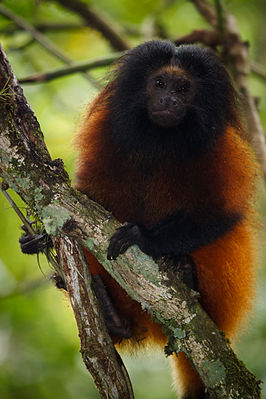Black-headed lion tamarin
| Black-headed lion tamarin | ||||||||||||
|---|---|---|---|---|---|---|---|---|---|---|---|---|

Black- headed lion tamarin ( Leontopithecus caissara ) |
||||||||||||
| Systematics | ||||||||||||
|
||||||||||||
| Scientific name | ||||||||||||
| Leontopithecus caissara | ||||||||||||
| Lorini & Persson , 1990 |
The black- headed lion tamarin ( Leontopithecus caissara ) is a primate species from the genus of lion tamarins , which belongs to the family of marmosets (Callitrichidae). The species was not scientifically described until 1990 and is one of the most threatened American primate species.
description
Black-headed lion tamarins are characterized by a predominantly golden-yellow fur, the head, mane, front and rear paws and tail are black. As with all lion tamarins, their face and paws are hairless and the long fingers, with the exception of the first toe of the hind paws, end in claws. The head body length of these primates is around 30 centimeters, the tail can be up to 40 centimeters long and the weight is around 600 grams.
distribution and habitat
Black-headed lion tamarins live in a small area in the border region of the Brazilian states of São Paulo and Paraná . First they were discovered on the island of Superagüi , later also on the mainland. Their habitat are tropical rainforests, where they mainly live on trees covered with lianas and other creepers.
Way of life
These primates are diurnal and mostly sleep in tree hollows at night. Like the other lion tamarins, they live in family groups of two to eleven animals, most of which are made up of an adult couple and their offspring. The groups are territorial and live in an area of around 25 hectares.
The diet of these animals consists mainly of fruits, but they also eat insects and small vertebrates.
Reproduction
Once a year the female usually gives birth between September and March, with twin births predominating. The father and the other group members take part in raising the young. They are weaned after around three months.
threat
The small distribution area of the black-headed lion tamarin is fragmented into several populations. The largest group (around 180 animals) live in the Superagui National Park and enjoy a certain protection there, the total population is estimated at no more than 400 animals. The IUCN lists the species as " critically endangered ".
literature
- Thomas Geissmann : Comparative Primatology. Springer-Verlag, Berlin et al. 2003, ISBN 3-540-43645-6 .
- Ronald M. Nowak: Walker's Mammals of the World. 6th edition. Johns Hopkins University Press, Baltimore MD 1999, ISBN 0-8018-5789-9 .
Web links
- Leontopithecus caissara in the Red List of Endangered Species of the IUCN 2009. Posted by: M. C. M. Kierulff u. a., 2008. Retrieved November 5, 2009.
- Figure and brief information on arkive.org (English)